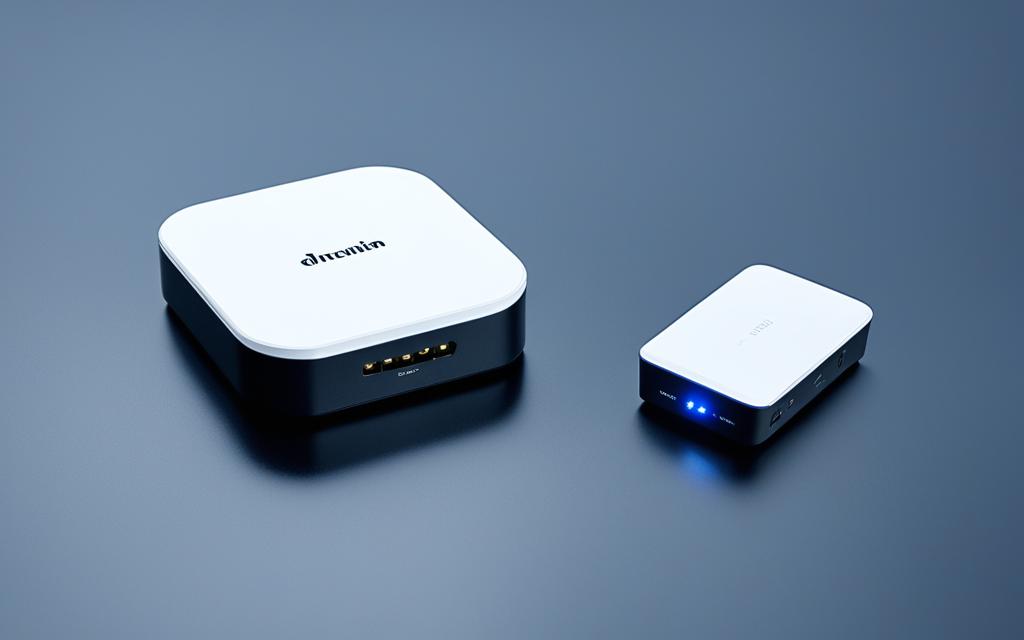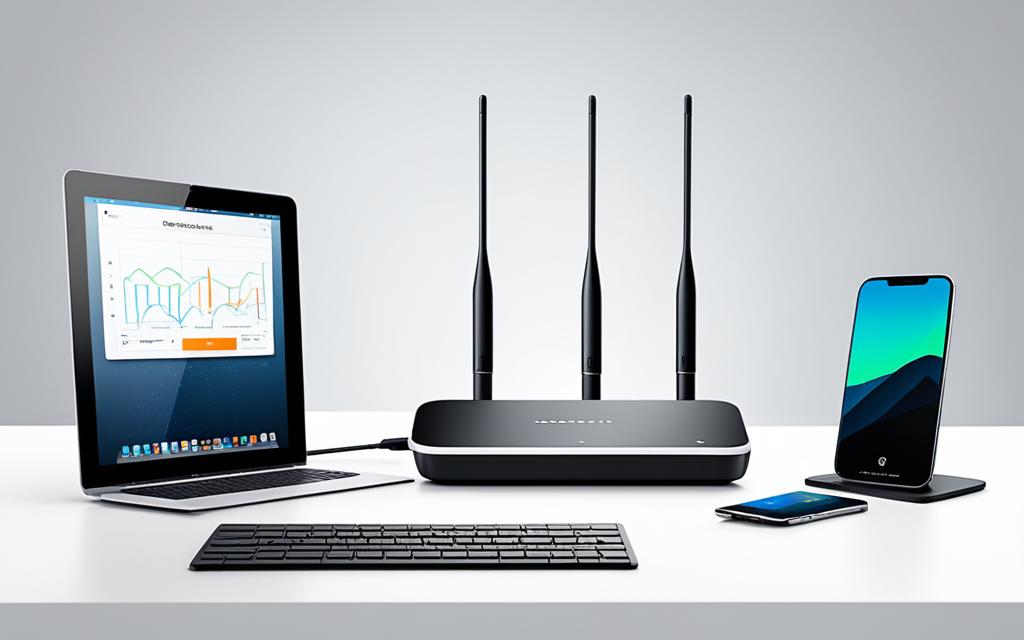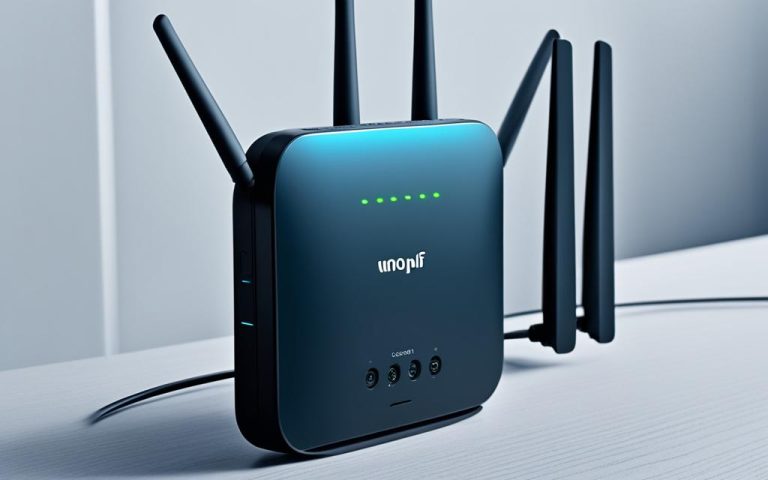PANs, or Personal Area Networks, are designed to connect electronic devices within a short range, typically around an individual person’s workspace. Wireless USB technology allows for seamless, high-speed connectivity in PANs, enabling the bridging of devices without the need for physical cables.
With the ability to replace Ethernet cabling in hard-to-reach or hazardous locations, Wireless USB bridges in PANs provide reliable wireless communication and support various network protocols such as PROFINET, EtherNet/IP, Modbus-TCP, and more.
The Anybus Wireless Bridge: Industrial Wireless Communication
The Anybus Wireless Bridge is an innovative and versatile device that revolutionizes wireless communication in industrial settings. With its seamless integration of Bluetooth and WLAN technologies, it provides a reliable and efficient solution for bridging industrial Ethernet or serial cables in even the most challenging environments.
Designed to meet the demands of industrial Ethernet networks, the Anybus Wireless Bridge offers a range of features that enhance connectivity and streamline operations. Its robust communication capabilities enable wireless communication up to 400 meters, making it ideal for applications in hard-to-reach or hazardous locations.
One of the key advantages of the Anybus Wireless Bridge is its ability to communicate via both Bluetooth and WLAN. This enables bridging of industrial Ethernet or serial cables without the need for expensive or maintenance-heavy cabling. With the Anybus Wireless Bridge, industrial Ethernet networks can now be established seamlessly, eliminating the limitations of physical cables and enhancing flexibility in network deployment.
The Anybus Wireless Bridge is designed for easy setup, allowing users to quickly establish a wireless connection with minimal effort. Its intuitive interface and advanced configuration options ensure that the installation process is efficient and hassle-free. Whether it’s configuring network settings or fine-tuning communication parameters, the Anybus Wireless Bridge offers flexibility and convenience to meet specific industrial requirements.
Security is a top priority in industrial environments, and the Anybus Wireless Bridge delivers on this front as well. It incorporates robust security features, protecting sensitive data and ensuring secure industrial operations. With built-in encryption and authentication mechanisms, the Anybus Wireless Bridge provides peace of mind for users, safeguarding against unauthorized access and potential cyber threats.
Take a look at the image below to see the Anybus Wireless Bridge in action:
Key Features of the Anybus Wireless Bridge:
- Supports up to 400 meters of wireless communication
- Communicates via Bluetooth and WLAN
- Eliminates the need for physical cables
- Easy setup and advanced configuration options
- Robust security features for secure industrial operations
With its unrivaled performance and advanced features, the Anybus Wireless Bridge sets a new standard for wireless communication in industrial Ethernet networks. It offers a reliable and efficient solution for seamless connectivity, eliminating the limitations of physical cables and providing greater flexibility in network deployment.
Key Features and Benefits of the Anybus Wireless Bridge
The Anybus Wireless Bridge offers a range of features and benefits that make it a reliable and efficient solution for wireless connectivity in PANs.
Features:
- Ability to operate leading TCP/IP-based industrial Ethernet networks
- Support for protocols like BACnet/IP, EtherNet/IP, Modbus-TCP, and PROFINET
- Compatibility with the Anybus Wireless Bolt for machine mounting
- Easy setup via push button or web interface
- Advanced configuration options
Benefits:
- Seamless wireless connectivity in PANs
- Replacement of physical cables in hard-to-reach or hazardous locations
- Reliable wireless communication for industrial Ethernet networks
- Enhanced security features for a secure industrial operation
- Rugged IP65 rated industrial design
- Support for multiple wireless interfaces such as Wireless LAN, Bluetooth classic, and Bluetooth Low Energy
The Anybus Wireless Bridge provides a reliable and efficient solution for wireless connectivity in PANs. With its versatile features and robust design, it enables seamless wireless communication in industrial Ethernet networks. The compatibility with leading network protocols ensures smooth integration into existing systems. The easy setup and advanced configuration options make it user-friendly and adaptable to various application requirements. Additionally, the Anybus Wireless Bridge offers enhanced security features for a secure industrial operation. The rugged IP65 rated industrial design ensures durability in harsh environments. With support for multiple wireless interfaces, it provides flexibility in connectivity options. Overall, the Anybus Wireless Bridge is a powerful solution that offers a multitude of benefits for wireless connectivity in PANs.
Wireless LAN Interface and Bluetooth Interface
The Anybus Wireless Bridge offers a versatile wireless LAN interface that supports a range of standards including WLAN 802.11 a, b, g, n, and d. This interface allows for seamless connectivity in PANs, enabling devices to communicate wirelessly within a specified range. The wireless LAN interface can operate in both access point and client mode, providing flexibility in PANs based on specific requirements.
This wireless LAN interface also prioritizes security, ensuring the confidentiality and integrity of data transmission. It supports various security features such as WEP 64/128, WPA, WPA-PSK, WPA2, TKIP, AES/CCMP, LEAP, and PEAP. These security protocols mitigate the risk of unauthorized access and protect sensitive information exchanged within the PAN.
In addition to the wireless LAN interface, the Anybus Wireless Bridge features a Bluetooth interface that further enhances connectivity within PANs. The Bluetooth interface supports both PAN (Personal Area Network) and PANU (Personal Area Networking User) profiles, enabling seamless communication between devices.
Similar to the wireless LAN interface, the Bluetooth interface operates in access point and client mode, providing flexibility based on the device’s role within the PAN. The Bluetooth interface also incorporates robust security measures, including authentication and authorization, encryption and data protection, as well as privacy and confidentiality features. This ensures that data exchanged over the Bluetooth connection remains secure and protected from unauthorized access.
Furthermore, the Bluetooth interface of the Anybus Wireless Bridge supports Bluetooth Low Energy (BLE) technology, which is particularly beneficial in PANs where power consumption is a crucial factor. BLE allows devices to communicate with minimal energy usage, enabling efficient and long-lasting wireless connectivity within the PAN.

Advantages of the Wireless LAN and Bluetooth Interfaces
- Seamless wireless connectivity within PANs
- Flexibility in operating modes (access point/client)
- Support for a wide range of WLAN and Bluetooth standards
- Enhanced security features to protect data transmission
- Efficient power consumption with Bluetooth Low Energy
Comparison of Wireless LAN and Bluetooth Interfaces
| Wireless LAN Interface | Bluetooth Interface |
|---|---|
| Supports WLAN 802.11 a, b, g, n, and d standards | Supports PAN and PANU profiles |
| Operates in access point and client mode | Operates in access point and client mode |
| Provides security features like WEP, WPA, WPA2 | Offers authentication, encryption, and privacy features |
| Enables wireless bridging in PANs | Supports Bluetooth Low Energy technology |
Ethernet Interface and Routing/Bridging Functions
The Anybus Wireless Bridge is equipped with a versatile Ethernet interface that supports various protocols, allowing for seamless data transmission and connectivity in PANs. The Ethernet protocols supported by the Anybus Wireless Bridge include IP, TCP, UDP, HTTP, LLDP, ARP, and DHCP, enabling efficient communication and networking.
One of the key capabilities of the Anybus Wireless Bridge is its ability to wirelessly bridge industrial Ethernet protocols such as BACnet/IP, EtherNet/IP, Modbus-TCP, and PROFINET. This bridging functionality facilitates the integration of devices and systems operating on different Ethernet protocols, enhancing connectivity and interoperability in PANs.
Routing Mode
In routing mode, the Anybus Wireless Bridge offers flexible operation modes to cater to diverse networking requirements. It supports fixed-IP, PPPoE, and DHCP configurations, allowing users to choose the most suitable mode for their specific application. The routing capabilities enable efficient routing of Ethernet packets between devices within the PAN, optimizing network performance and ensuring seamless communication.
Bridging Mode
When operating in bridging mode, the Anybus Wireless Bridge acts as a bridge between PAN and Ethernet networks. It facilitates the seamless transmission of data between PAN devices and Ethernet-based systems, eliminating the need for physical cables and enabling wireless connectivity across the network. This bridging mode enhances the flexibility and scalability of PANs, making them more adaptable to changing connectivity requirements.
The Ethernet interface and routing/bridging functions of the Anybus Wireless Bridge are essential components that contribute to the efficient operation of PANs. By supporting various Ethernet protocols and providing flexible routing and bridging capabilities, this device ensures seamless data transmission, enhanced connectivity, and improved network performance in PANs.
| Protocol | Description |
|---|---|
| IP | Internet Protocol |
| TCP | Transmission Control Protocol |
| UDP | User Datagram Protocol |
| HTTP | Hypertext Transfer Protocol |
| LLDP | Link Layer Discovery Protocol |
| ARP | Address Resolution Protocol |
| DHCP | Dynamic Host Configuration Protocol |
PANs vs. LANs/WANs: Differences in Connectivity and Range
While PANs and LANs/WANs both serve the purpose of connecting devices, there are key differences in their connectivity methods and range. PANs, particularly wireless PANs, use technologies like Bluetooth and Wi-Fi to enable wireless connectivity within a short range, typically up to 10 meters. These wireless PANs offer mobility and ease of use, eliminating the need for cables and physical ports.
“Wireless PANs offer seamless connectivity and freedom of movement, allowing users to connect devices effortlessly without physical limitations.”
On the other hand, LANs and WANs rely on wired connections like Ethernet cables for faster data transfer rates and more stable connections. They serve larger areas like buildings or cities, providing connectivity over a wider range. Wired LANs offer reliable and secure connections, making them suitable for applications that require high bandwidth and low latency. WANs, on the other hand, connect geographically dispersed networks and provide connectivity over vast areas.
“LANs and WANs offer robust connectivity over larger areas, making them suitable for businesses and organizations that require network connectivity at scale.”
Overall, the choice between PANs, LANs, and WANs depends on the specific requirements of the network and the desired range of connectivity. Wireless PANs provide convenience and mobility within a limited range, while wired LANs and WANs offer greater coverage and stability over larger areas.
With the advancements in wireless technology and the increasing demand for connectivity, PANs, LANs, and WANs all play crucial roles in enabling seamless communication in various environments.
The Future of PANs: Emerging Trends and Innovations
As technology continues to advance, Personal Area Networks (PANs) are evolving to meet the demands of the future. The integration of PANs with personal devices, the Internet of Things (IoT), and advancements in IEEE standards is set to shape the future of connectivity.
One exciting development is the integration of PANs with body area networks (BANs), which opens up possibilities for real-time health monitoring and personalized healthcare services. By seamlessly connecting wearable devices and sensors within PANs, individuals can monitor their health in real-time and receive personalized feedback and recommendations.
The evolution of IEEE standards is also driving the future of PANs. With continuous advancements, the data transfer rates within PANs are set to increase, enabling faster and more efficient communication between devices. Additionally, enhanced security protocols are being implemented to ensure the privacy and integrity of data transmitted within PANs. Energy-efficient technologies are also at the forefront, aiming to optimize power consumption and prolong the battery life of personal devices connected to PANs.
Beyond personal devices, PANs are expected to play a vital role in the integration of IoT devices. By connecting various IoT devices within PANs, automation and efficiency can be achieved in homes, workplaces, and cities. PANs enable seamless communication between IoT devices, allowing for personalized operations and optimized utilization of resources.
The future of PANs looks promising with the integration of personal devices, the IoT, and advancements in IEEE standards. As technology continues to evolve, PANs will provide individuals and businesses with enhanced connectivity, personalized experiences, and efficient operations.
Conclusion
Wireless USB technology in PANs offers the advantage of seamless, high-speed connectivity by bridging devices without the need for physical cables. The Anybus Wireless Bridge, with its reliable and efficient solution for wireless communication in industrial Ethernet networks, is a valuable asset. It supports leading protocols, provides easy setup, advanced configuration options, and robust security.
As PANs continue to evolve and integrate with emerging technologies, they are set to play a pivotal role in shaping the future of connectivity for businesses and individuals. The ability to connect devices wirelessly within a short range brings flexibility, mobility, and increased productivity. With the Anybus Wireless Bridge, industrial Ethernet networks can be easily accessed and connected, eliminating the constraints of cabling and enhancing operational efficiency.
With the ever-increasing demand for wireless connectivity, PANs and devices like the Anybus Wireless Bridge are at the forefront of driving innovation and enabling seamless communication. As we look towards the future, PANs will continue to contribute to the development of interconnected environments, supporting automation, personalization, and improved efficiency.
FAQ
What are PANs and how do they connect devices?
PANs, or Personal Area Networks, are designed to connect electronic devices within a short range, typically around an individual person’s workspace. They use technologies like Bluetooth and Wi-Fi to enable wireless connectivity and eliminate the need for physical cables.
What is Wireless USB technology and how does it enable high-speed connectivity in PANs?
Wireless USB technology allows for seamless, high-speed connectivity in PANs by bridging devices without the need for physical cables. It replaces Ethernet cabling in hard-to-reach or hazardous locations, providing reliable wireless communication and supporting various network protocols.
What is the Anybus Wireless Bridge and how does it support industrial wireless communication?
The Anybus Wireless Bridge is a versatile device that supports up to 400 meters of reliable wireless communication in industrial settings. It can communicate via both Bluetooth and WLAN, making it an ideal solution for bridging industrial Ethernet or serial cables in hard-to-reach or hazardous locations.
What are some key features of the Anybus Wireless Bridge?
The Anybus Wireless Bridge offers features such as compatibility with leading TCP/IP-based industrial Ethernet networks, support for protocols like BACnet/IP, EtherNet/IP, Modbus-TCP, and PROFINET, easy setup via push button or web interface, advanced configuration options, and security features for a secure industrial operation.
What wireless interfaces does the Anybus Wireless Bridge support?
The Anybus Wireless Bridge supports multiple wireless interfaces such as Wireless LAN, Bluetooth classic, and Bluetooth Low Energy. The wireless LAN interface supports standards like WLAN 802.11 a, b, g, n, and d, while the Bluetooth interface supports PAN and PANU profiles and Bluetooth Low Energy technology.
What protocols does the Ethernet interface of the Anybus Wireless Bridge support?
The Ethernet interface of the Anybus Wireless Bridge supports Ethernet protocols such as IP, TCP, UDP, HTTP, LLDP, ARP, and DHCP. It also enables the wireless bridging of industrial Ethernet protocols like BACnet/IP, EtherNet/IP, Modbus-TCP, and PROFINET.
How do PANs differ from LANs/WANs in terms of connectivity and range?
PANs, particularly wireless PANs, use technologies like Bluetooth and Wi-Fi to enable wireless connectivity within a short range, typically up to 10 meters. On the other hand, LANs and WANs rely on wired connections like Ethernet cables for faster data transfer rates and more stable connections, serving larger areas like buildings or cities.
What is the future of PANs and what role will they play with emerging technologies?
The future of PANs lies in the integration of personal devices, the Internet of Things (IoT), and advancements in IEEE standards. PANs integrated with body area networks (BANs) open up possibilities for real-time health monitoring and personalized healthcare services. Advances in IEEE standards aim to increase data transfer rates, enhance security protocols, and develop energy-efficient technologies for PANs. PANs will also play a crucial role in the connectivity of IoT devices, enabling automation, efficiency, and personalized operations.




















One Comment